Assess Your IT Financial Management Maturity Effectively
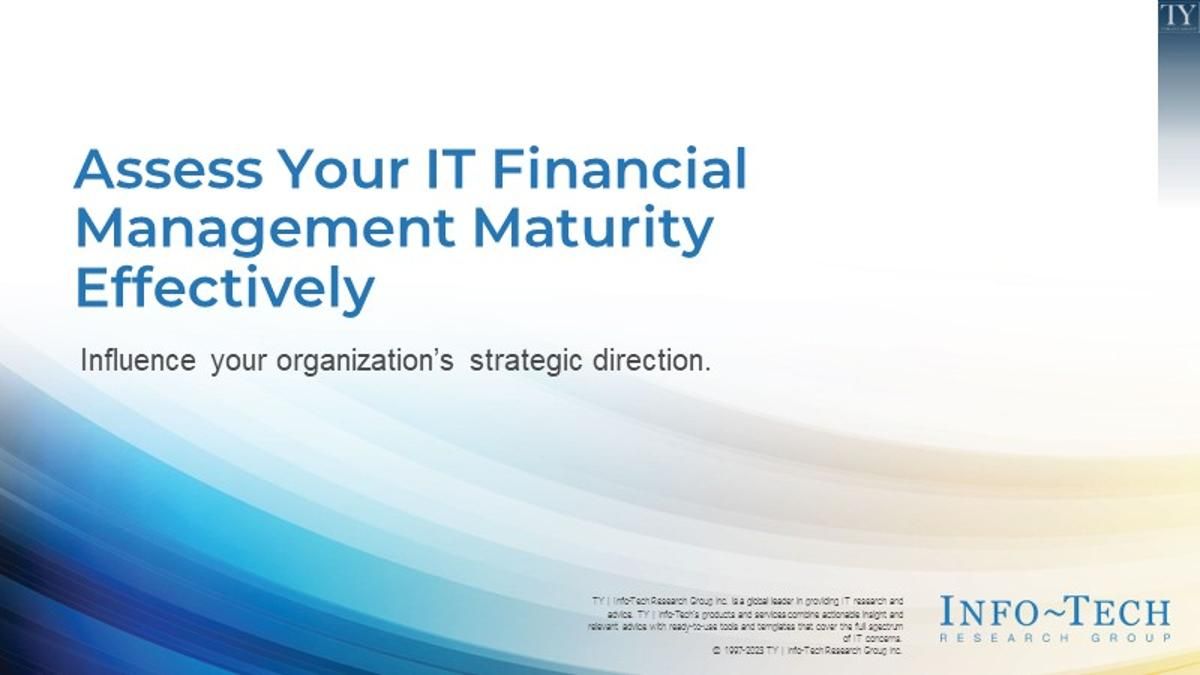
Organizations wishing to mature their IT financial management (ITFM) maturity often face the following obstacles:
- Unfamiliarity: Lack of knowledge and understanding related to ITFM maturity.
- Shortsightedness: Randomly reacting to changing circumstances.
- Exchange: Inability to consistently drive dialogues.
- Perception: IT is perceived as a cost center instead of a trustworthy strategic partner.
Our Advice
Critical Insight
No matter where you currently stand in your ITFM practice, there is always room for improvement. Hence, a maturity assessment should be viewed as a self-improvement tool that is only valuable if you are willing to act on it.
Impact and Result
A mature ITFM practice leads to many benefits.
- Foundation: Improved governance, skill sets, processes, and tools.
- Data: An appropriate taxonomy/data model alongside accurate data for high-quality reporting and insights.
- Language: A common vocabulary across the organization.
- Organization Culture: Improved communication and collaboration between IT and business partners.
Assess Your IT Financial Management Maturity Effectively Research & Tools
Besides the small introduction, subscribers and consulting clients within this management domain have access to:
1. Assess Your IT Financial Management Maturity Effectively Storyboard – A framework and step-by-step methodology to assess your ITFM maturity.
This research seeks to support IT leaders and ITFM practitioners in evaluating and improving their current maturity. It will help document both current and target states as well as prioritize focus areas for improvement.
- Assess Your IT Financial Management Maturity Effectively Storyboard
2. IT Financial Management Maturity Assessment Tool – A structured tool to help you assess your ITFM maturity.
This Excel workbook guides IT finance practitioners to effectively assess their IT financial management practice. Incorporate the visual outputs into your final executive presentation document. Key activities include context setting, completing the assessment, and prioritizing focus areas based on results.
- IT Financial Management Maturity Assessment Tool
3. IT Financial Management Maturity Assessment Report Template – A report summarizing your ITFM maturity assessment results to help you communicate with stakeholders.
Use this template to document your final ITFM maturity outputs, including the current and target states and your identified priorities.
- IT Financial Management Maturity Assessment Report Template
Further reading
Assess Your IT Financial Management Maturity Effectively
Influence your organization’s strategic direction.
Analyst Perspective
Make better informed data-driven business decisions.
Technology has been evolving throughout the years, increasing complexity and investments, while putting more stress on operations and people involved. As an IT leader, you are now entrusted to run your outfit as a business, sit at the executive table as a true partner, and be involved in making decisions that best suit your organization. Therefore, you have an obligation to fulfill the needs of your end customers and live up to their expectations, which is not an easy task.
IT financial management (ITFM) helps you generate value to your organization’s clientele by bringing necessary trade-offs to light, while driving effective dialogues with your business partners and leadership team.
This research will focus on Info-Tech’s approach to ITFM maturity, aiming for a state of continuous improvement, where an organization can learn and grow as it adapts to change. As the ITFM practice matures, IT and business leaders will be able to better understand one another and together make better business decisions, driven by data.
This client advisory presentation and accompanying tool seek to support IT leaders and ITFM practitioners in evaluating and improving their current maturity. It will help document both current and target states as well as prioritize focus areas for improvement.

|
Bilal Alberto Saab
Research Director, IT Financial Management Info-Tech Research Group |
Executive Summary
The value of ITFM is undermined
ITFM is often discarded and not given enough importance and relevance due to the operational nature of IT, and the specialized skillset of its people, leading to several problems and challenges, such as:
- Unfamiliarity: Lack of knowledge and understanding related to ITFM maturity.
- Shortsightedness: Randomly reacting to changing circumstances.
- Exchange: Inability to consistently drive dialogues.
- Perception: IT is perceived as a cost center instead of a trustworthy strategic partner.
Constructive dialogues with business partners are not the norm
Business-driven conversations around financials (spending, cost, revenue) are a rarity in IT due to several factors, including:
- Foundation: Weak governance, inadequate skillset, and less than perfect processes and tools.
- Data: Lack of adequate taxonomy/data model, alongside inaccurate data leading to poor reporting and insights.
- Language: Lack of a common vocabulary across the organization.
- Organization culture: No alignment, alongside minimal communication and collaboration between IT and business partners.
Follow Info-Tech’s approach to move up the ITFM maturity ladder
Mature your ITFM practice by activating the means to make informed business decisions.
Info-Tech’s methodology helps you move the dial by focusing on three maturity focus areas:
- Build an ITFM Foundation
- Manage and Monitor IT Spending
- Bridge the Language Barrier
Info-Tech Insight
Influence your organization’s strategic direction by maturing your ITFM practice.
What is ITFM?
ITFM is not just about finance.
- ITFM has evolved from traditional budgeting, accounting, and cost optimization; however, it is much more than those activities alone.
- It starts with understanding the financial implications of technology by adopting different perspectives to become adept in communicating with various stakeholders, including finance, business partners, IT managers, and your CEO.
- Armed with this knowledge, ITFM helps you address a variety of questions, such as:
- How are technology funds being spent?
- Which projects is IT prioritizing and why?
- What are the resources needed to speed IT delivery?
- What’s the value of IT within the organization?
- ITFM’s main objective is thus to improve decision-making capabilities by facilitating communication between IT leaders and stakeholders, while enabling a customer focus attitude throughout the organization.
“ITFM embeds technology in financial management practices. Through cost, demand, and value, ITFM brings technology and business together, forging the necessary relationships and starting the right conversations to enable the best decisions for the organization.”
– Monica Braun, Research Director, Info-Tech Research Group
Your challenge
IT leaders struggle to articulate and communicate business value.
- IT spending is often questioned by different stakeholders, such as business partners and various IT business units. These questions, usually resulting from shifts in business needs, may revolve around investments, expenditures, services, and speed to market, among others. While IT may have an idea about its spending habits, aligning it to the business strategy may prove difficult.
- IT staff often does not have access to, or knowledge of, the business model and its intricacies. In an operational environment, the focus tends to be on technical issues rather than overall value.
- People tend to fear what they do not know. Some business managers may not be comfortable with technology. They do not recognize the implications and ramifications of certain implementations or understand the related terminology, which puts a strain on any conversation.
“Value is not the numbers you visualize on a chart, it’s the dialogue this data generates with your business partners and leadership team.”
– Dave Kish, Practice Lead, Info-Tech Research Group
Technology is constantly evolving
Increasing IT spending and decision-making complexity.
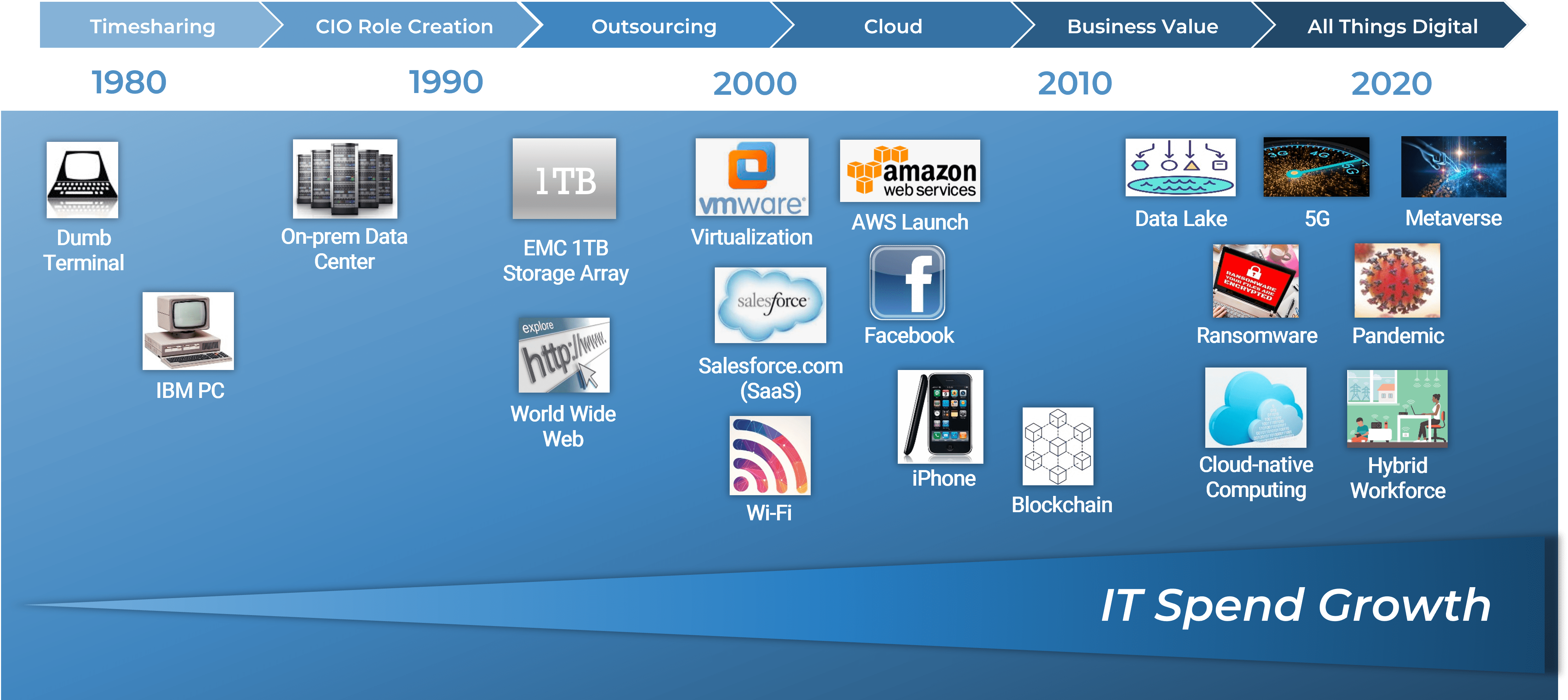
Common obstacles
IT leaders are not able to have constructive dialogues with their stakeholders.
- The way IT funds are spent has changed significantly, moving from the purchase of discrete hardware and software tools to implementing data lakes, cloud solutions, the metaverse and blockchain. This implies larger investments and more critical decisions. Conversations around interoperability, integration, and service-based solutions that focus more on big-picture architecture than day-to-day operations have become the norm.
- Speed to market is now a survival criterion for most organizations, requiring IT to shift rapidly based on changing priorities and customer expectations. This leads to the need for greater financial oversight, with the CFO as the gatekeeper. Today’s IT leaders need to possess both business and financial management savvy to justify their spending with various stakeholders.
- Any IT budget increase is tied to expectations of greater value. Hence, the compelling demands for IT to prove its worth to the business. Promoting value comes in two ways: 1) objectively, based on data, KPIs, and return on investment; and 2) subjectively, based on stakeholder satisfaction, alongside relationships. Building trust, credibility, and confidence can go a long way.
In a technology-driven world, advances come at a price. With greater spending required, more complex and difficult conversations arise.
Constructive dialogues are key
You don’t know what you don’t know.
- IT, being historically focused on operations, has become a hub for technically savvy personnel. On the downside, technology departments are often alien to business, causing problems such as:
- IT staff have no knowledge of the business model and lack customer focus.
- Business is not comfortable with technology and related jargon.
- The lack of two-way communication and business alignment is hence an important ramification. If the business does not understand technology, and IT does not speak in business terms, where does that lead us?
- Poor data quality and governance practices, alongside overly manual processes can only exasperate the situation.
IT Spending Survey
79% of respondents believe that decisions taking too long to make is either a significant or somewhat of a challenge (Flexera 2022 Tech Spend Pulse; N=501).
81% of respondents believe that ensuring spend efficiency (avoiding waste) is either a challenge or somewhat of a challenge (Flexera 2022 Tech Spend Pulse; N=501).
ITFM is trailing behind
IT leaders must learn to speak business.
In today’s world, where organizations are driving customer experience through technology investments, having a seat at the table means IT leaders must be well versed in business language and practice, including solid financial management skills.
However, IT staff across all industries aren’t very confident in how well IT is doing in managing its finances. This becomes evident after looking at three core processes:
- Demonstrating IT’s value to the business.
- Accounting of costs and budgets.
- Optimizing costs to gain the best return on investment.
Recent data from 4,137 respondents to Info-Tech’s IT Management & Governance Diagnostic shows that while most IT staff feel that these three financial management processes are important, notably fewer feel that IT management is effective at executing on them.
IT leadership’s capabilities around fundamental cost data capture appear to be lagging, not to mention the essential value-added capabilities around optimizing costs and demonstrating IT’s contribution to business value.
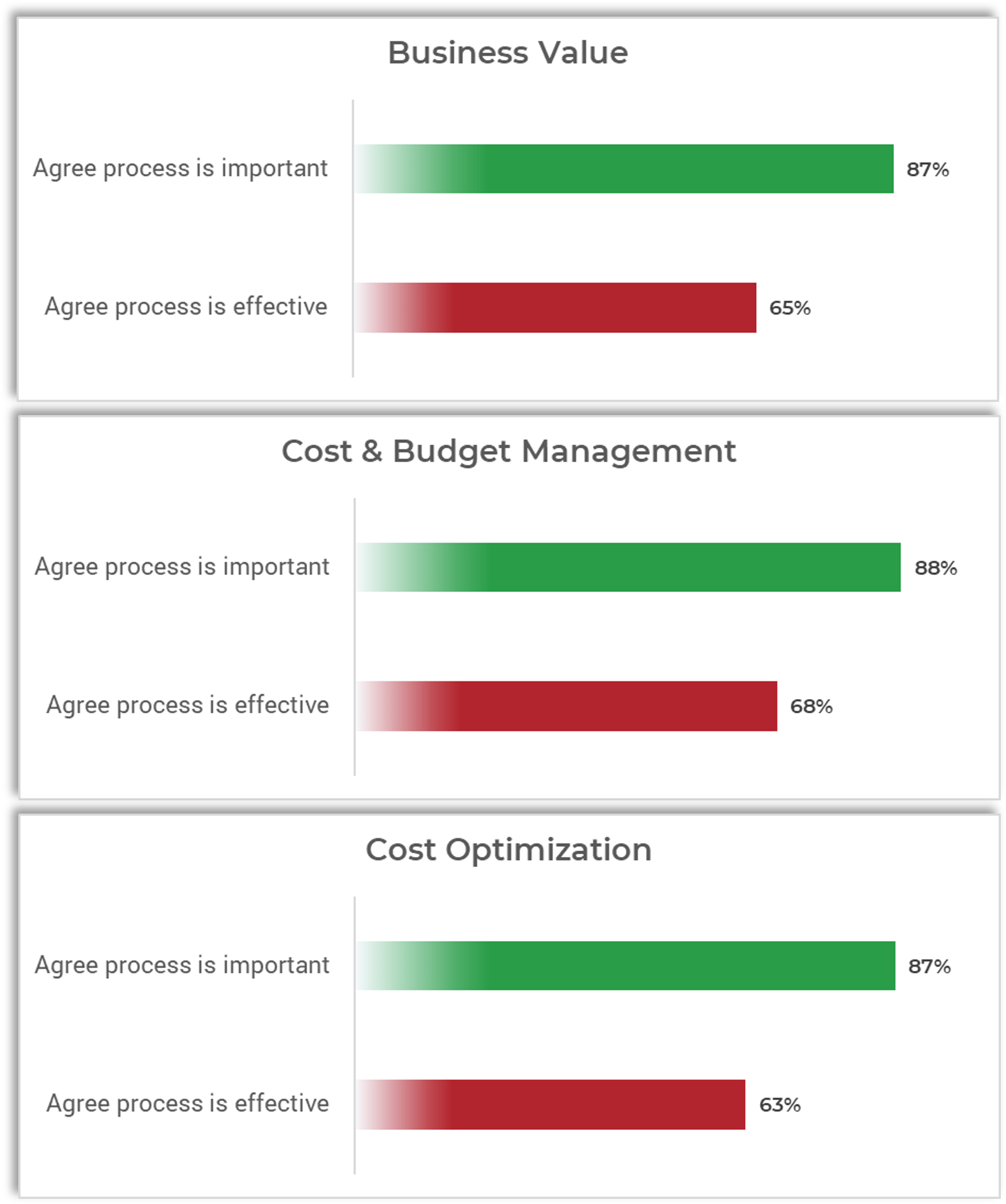
Source: Info-Tech Research Group, IT Management & Governance Diagnostic, 2023.
Info-Tech’s approach
We take a holistic approach to ITFM and support you throughout your maturity journey.
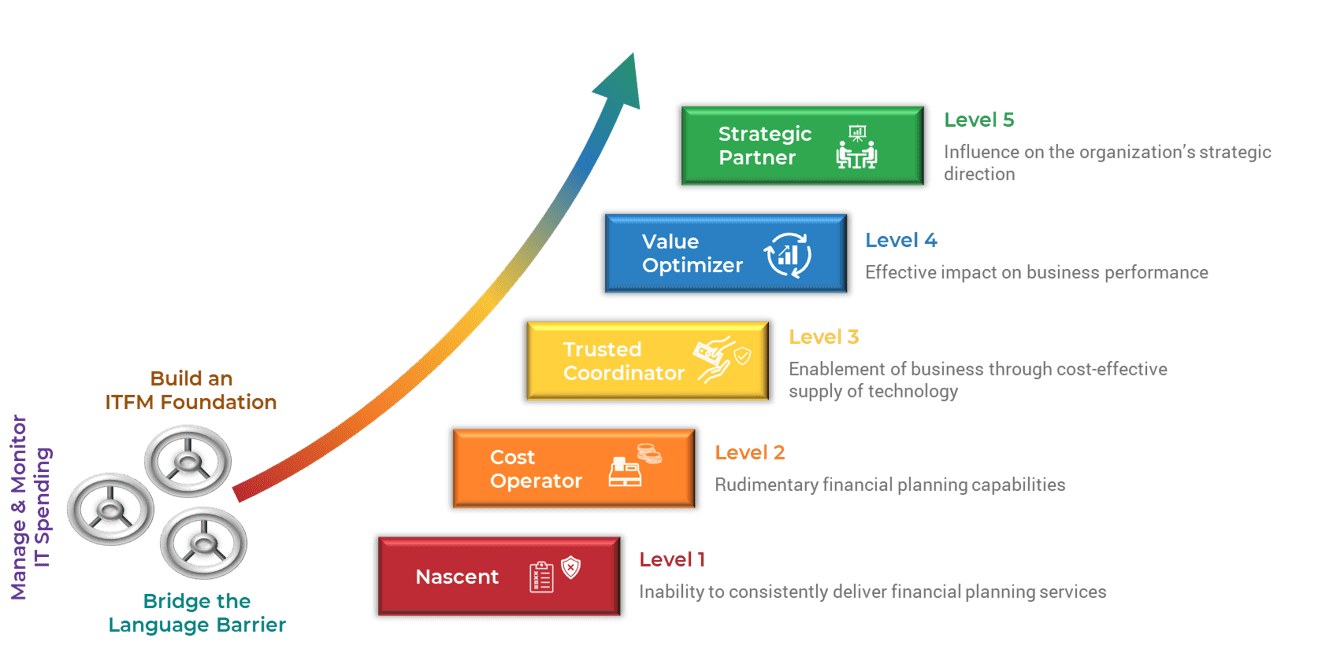
The Info-Tech difference:
- Info-Tech has a methodology and set of tools that will help assess your ITFM maturity and take the first step in developing an improvement plan. We have identified three maturity focus areas:
- Build an ITFM Foundation
- Manage and Monitor IT Spending
- Bridge the Language Barrier
- No matter where you currently stand in your ITFM practice, there is always room for improvement. Hence, a maturity assessment should be viewed as a self-improvement tool, which is only valuable if you are willing to act on it.
Note: See Appendix A for maturity level definitions and descriptions.
Climb the maturity ladder
By growing along three maturity focus areas.
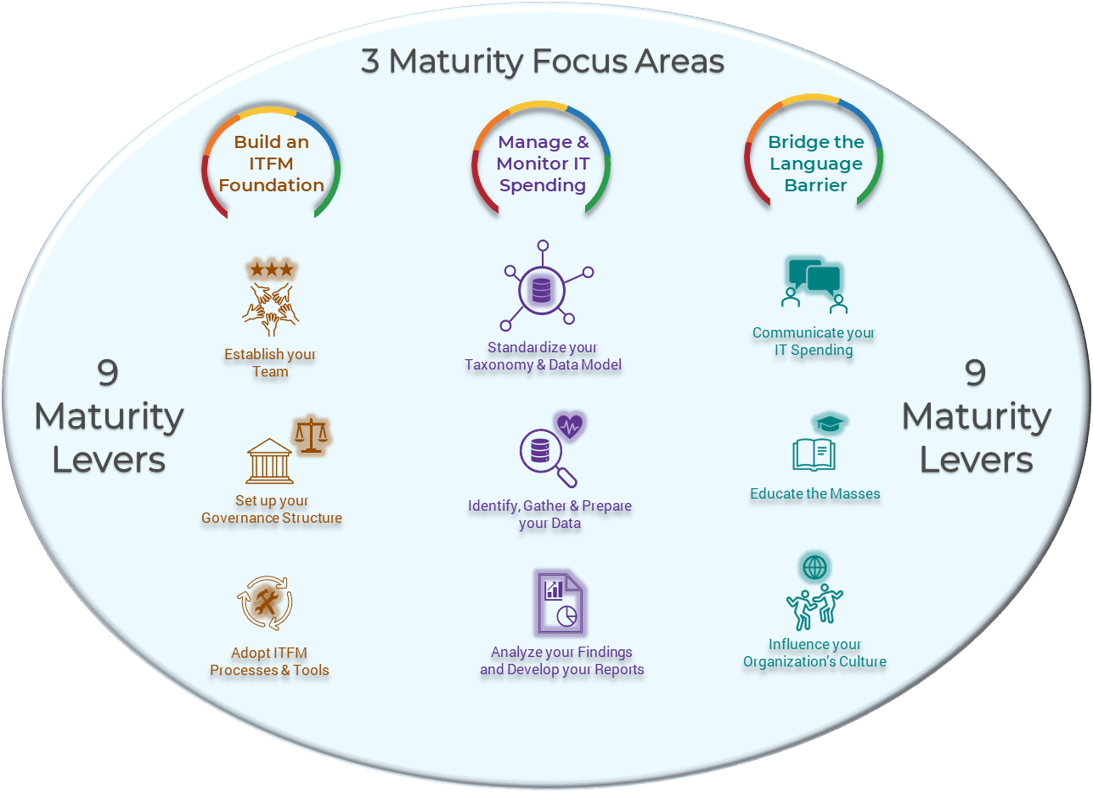
Info-Tech identified three maturity focus areas, each containing three levers.
Identify where you stand across the nine maturity levers, detect the gaps, and determine your priorities as a first step to develop an improvement plan.
Note: See Appendix B for maturity level definitions and descriptions per lever.
Key project deliverables
Each step of this activity is accompanied by supporting deliverables to help you accomplish your goals.
IT Financial Management Maturity Assessment Report Template
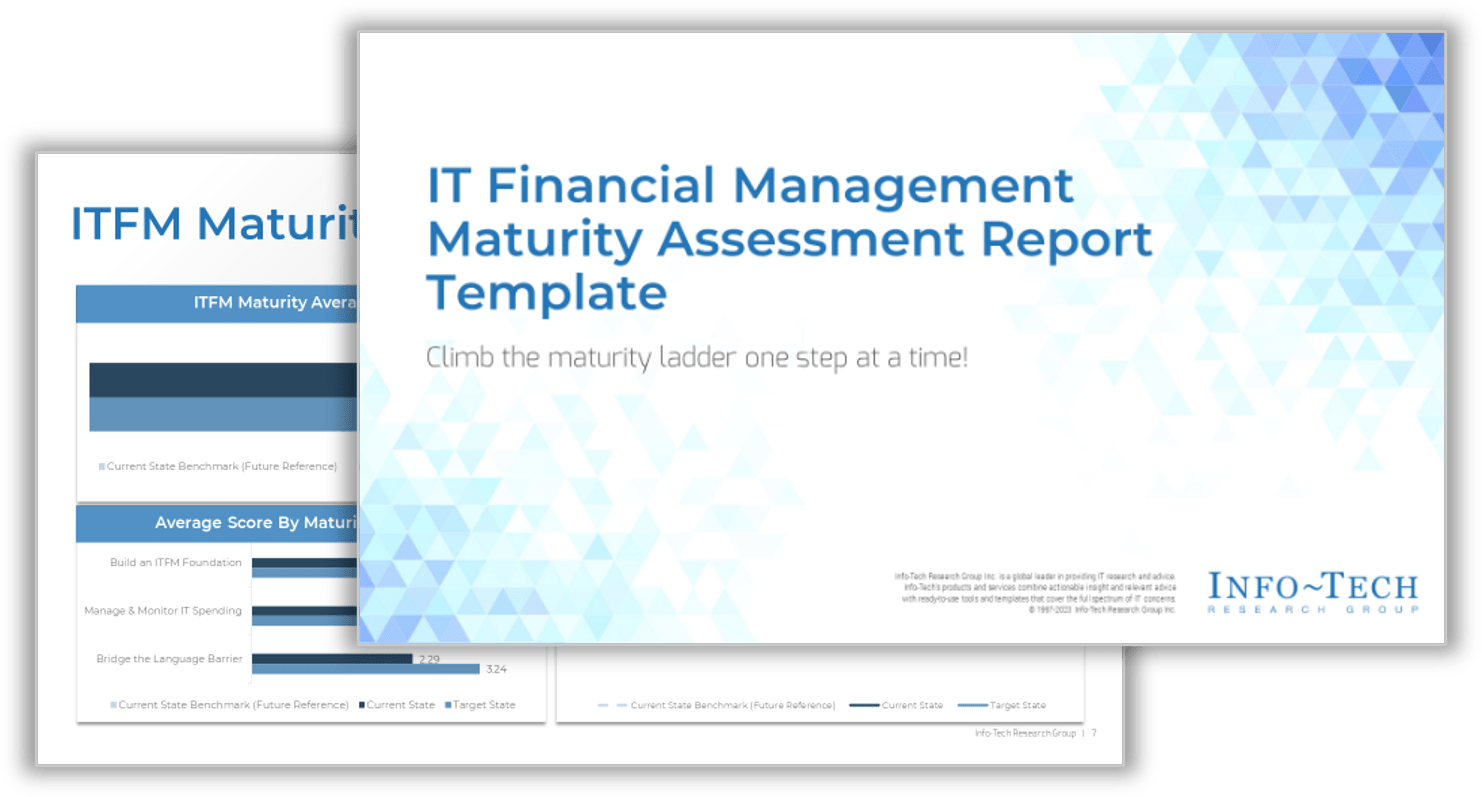
IT Financial Management Maturity Assessment Tool
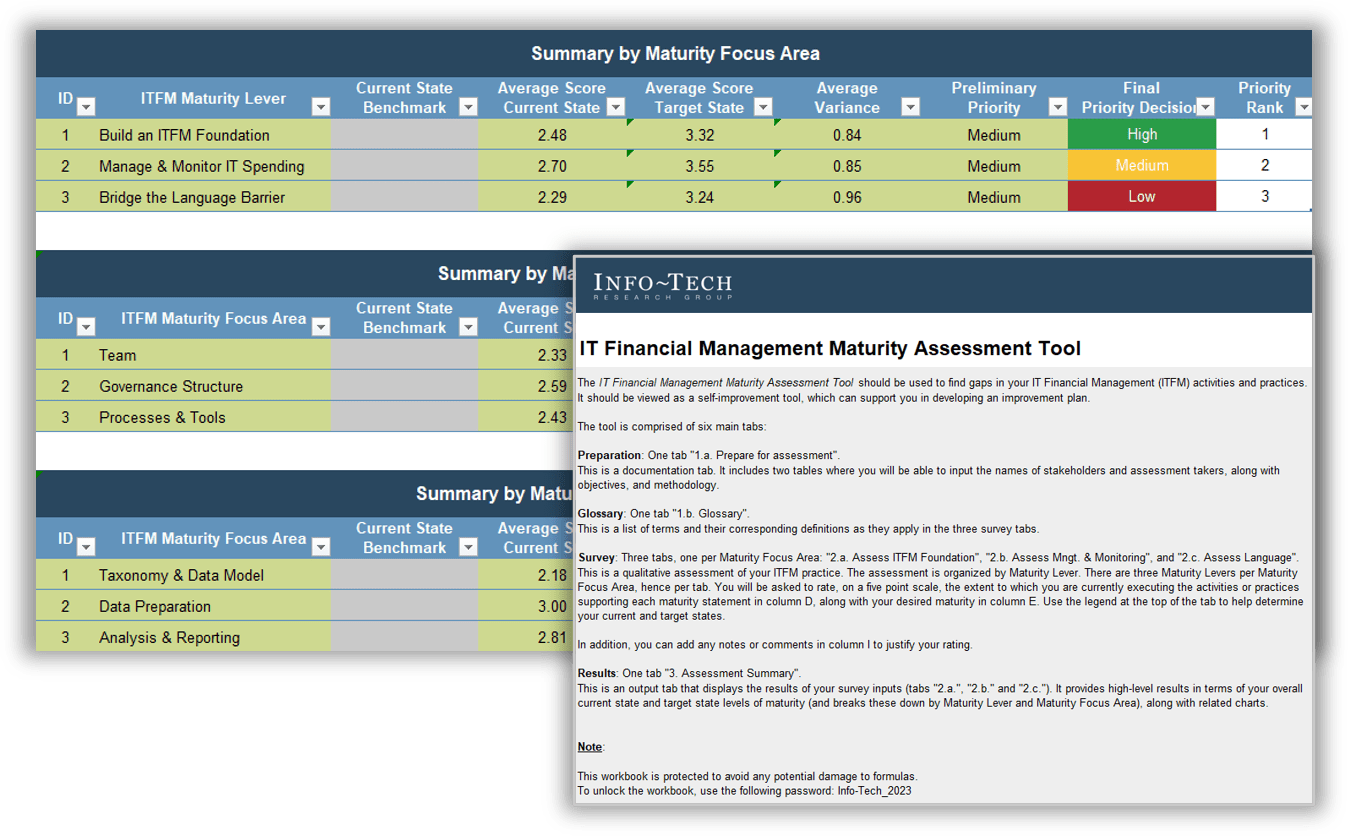
Measure the value of this activity
Reach your 12-month maturity target.
- Determine your 12-month maturity target, identify your gaps, and set your priorities.
- Use the ITFM maturity assessment to kickstart your improvement plan by developing actionable initiatives.
- Implement your initiatives and monitor your progress to reach your 12-month target.
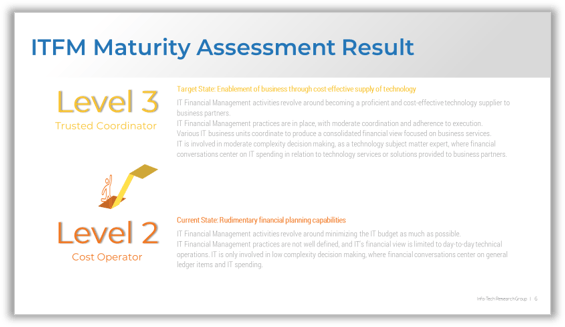
Build your improvement plan and implement your initiatives to move the dial and climb the maturity ladder.
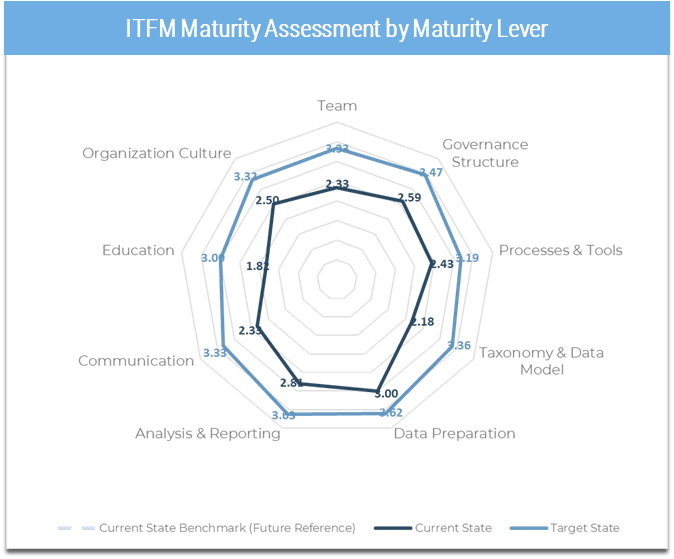
Info-Tech offers various levels of support to best suit your needs
DIY Toolkit |
Guided Implementation |
Workshop |
Consulting |
| "Our team has already made this critical project a priority, and we have the time and capability, but some guidance along the way would be helpful." | "Our team knows that we need to fix a process, but we need assistance to determine where to focus. Some check-ins along the way would help keep us on track." | "We need to hit the ground running and get this project kicked off immediately. Our team has the ability to take this over once we get a framework and strategy in place." | "Our team does not have the time or the knowledge to take this project on. We need assistance through the entirety of this project." |
Diagnostics and consistent frameworks used throughout all four options |
|||
Step 1
Prepare for the ITFM maturity assessment
Content Overview
- Identify your stakeholders
- Set the context
- Determine the methodology
- Identify assessment takers
This step involves the following participants:
- CIO/IT director
- CFO/finance director
- IT finance lead
- IT audit lead
- Other IT management
1. Prepare to take the ITFM maturity assessment
3 hours
Input: Understanding your context, objectives, and methodology
Output: ITFM maturity assessment stakeholders and their objectives, ITFM maturity assessment methodology, ITFM maturity assessment takers
Materials: 1a. Prepare for Assessment tab in the ITFM Maturity Assessment Tool
Participants: CIO/IT director, CFO/finance director, IT finance lead, IT audit lead, Other IT management
- Identify your stakeholders and document it in the ITFM Maturity Assessment Tool (see next slides). We recommend having representatives from different business units across the organization, most notably IT, IT finance, finance, and IT audit.
- Set the context with your stakeholders and document it in the ITFM Maturity Assessment Tool. Discuss the reason behind taking the ITFM maturity assessment among the various stakeholders. Why do each of your stakeholders want to take the assessment? What are their main objectives? What would they like to achieve?
- Determine the methodology and document it in the ITFM Maturity Assessment Tool. Discuss how you want to go about taking the assessment with your stakeholders. Do you want to have representatives from each business unit take the assessment individually, then share and discuss their findings? Do you prefer forming a working group with representatives from each business unit and go through the assessment together? Or does any of your stakeholders have a different suggestion? You will have to consider the effort, skillset, and knowledge required.
- Identify the assessment takers and document it in the ITFM Maturity Assessment Tool. Determine who will be taking the assessment (specific names of stakeholders). Consider their availability, knowledge, and skills.
Download the IT Financial Management Maturity Assessment Tool
TEMPLATE & EXAMPLE
Document your stakeholders, objectives, and methodology
Excel Workbook: ITFM Maturity Assessment Tool – Prepare for Assessment worksheet
Refer to the example and guidelines below on how to document stakeholders, objectives, and methodology (table range: columns B to G and rows 8 to 15).

| Column ID | Input Type | Guidelines |
| B | Formula | Automatic calculation, no entry required. |
| C | Text | Enter the full name of each stakeholder on a separate row. |
| D | Text | Enter the job title related to each stakeholder. |
| E | Text | Enter the objective(s) related to each stakeholder. |
| F | Text | Enter the agreed upon methodology. |
| G | Text | Enter any notes or comments per stakeholder (optional). |
Review the following in the Excel workbook as per guidelines:
- Navigate to the 1a. Prepare for Assessment tab.
- Enter the full names and job titles of the ITFM maturity assessment stakeholders.
- Document the maturity assessment objective of each of your stakeholders.
- Document the agreed-upon methodology.
Download the IT Financial Management Maturity Assessment Tool
TEMPLATE & EXAMPLE
Document your assessment takers
Excel Workbook: ITFM Maturity Assessment Tool – Prepare for Assessment worksheet
Refer to the example and guidelines below on how to document assessment takers (table range: columns B to E and rows 18 to 25).

| Column ID | Input Type | Guidelines |
| B | Formula | Automatic calculation, no entry required. |
| C | Text | Enter the full name of each assessment taker on a separate row. |
| D | Text | Enter the job title related to each stakeholder to identify which party is being represented per assessment taker. |
| E | Text | Enter any notes or comments per stakeholder (optional). |
Review the following in the Excel workbook as per guidelines:
- Navigate to the 1a. Prepare for Assessment tab.
- Enter the full name of each assessment taker, along with the job title of the stakeholder they are representing.
Download the IT Financial Management Maturity Assessment Tool
Step 2
Take the ITFM maturity assessment
Content Overview
- Complete the survey
- Review your assessment results
- Determine your priorities
This step involves the following participants:
- CIO/IT director
- CFO/finance director
- IT finance lead
- IT audit lead
- Other IT management
2. Take the ITFM maturity assessment
3 hours
Input: Understanding of your ITFM current state and 12-month target state, ITFM maturity assessment results
Output: ITFM current- and target-state maturity levels, average scores, and variance, ITFM current- and target-state average scores, variance, and priority by maturity focus area and maturity lever
Materials: 1b. Glossary, 2a. Assess ITFM Foundation, 2b. Assess Mngt. & Monitoring, 2c. Assess Language, and 3. Assessment Summary tabs in the ITFM Maturity Assessment Tool
Participants: CIO/IT director, CFO/finance director, IT finance lead, IT audit lead, Other IT management
- Complete the survey: select the current and target state of each statement – refer to the glossary as needed for definitions of key terms – in the ITFM Maturity Assessment Tool (see next slides). There are three tabs (one per maturity focus area) with three tables each (nine maturity levers). Review and discuss statements with all assessment takers: consider variations, differing opinions, and reach an agreement on each statement inputs.
- Review assessment results: navigate to the Assessment Summary tab in the ITFM maturity assessment tool (see next slides) to view your results. Review and discuss with all assessment takers: consider any shocking output and adjust survey input if necessary.
- Determine your priorities: decide on the priority (Low/Medium/High) by maturity focus area and/or maturity lever. Rank your maturity focus area priorities from 1 to 3 and your maturity lever priorities from 1 to 9. Consider the feasibility in terms of timeframe, effort, and skillset required, positive and negative impacts on business and technology, likelihood of failure, and necessary approvals.
Document your priorities in the ITFM maturity assessment tool (see next slides).
Review and discuss priorities with all assessment takers: consider variations, differing opinions, and reach an agreement on each priority.
Download the IT Financial Management Maturity Assessment Tool
TEMPLATE & EXAMPLE
Complete the survey
Excel workbook: ITFM Maturity Assessment Tool – Survey worksheets
Refer to the example and guidelines below on how to complete the survey.

| Column ID | Input Type | Guidelines |
| B | Formula | Automatic calculation, no entry required. |
| C | Formula | Automatic calculation, no entry required: ITFM maturity statement to assess. |
| D, E | Dropdown | Select the maturity levels of your current and target states. One of five maturity levels for each statement, from “1. Nonexistent” (lowest maturity) to “5. Advanced” (highest maturity). |
| F, G, H | Formula | Automatic calculation, no entry required: scores associated with your current and target state selection, along with related variance (column G – column F). |
| I | Text | Enter any notes or comments per ITFM maturity statement (optional). |
Review the following in the Excel workbook as per guidelines:
- Navigate to the survey tabs: 2a. Assess ITFM Foundation, 2b. Assess Management and Monitoring, and 2c. Assess Language.
- Select the appropriate current and target maturity levels.
- Add any notes or comments per ITFM maturity statement where necessary or helpful.
Download the IT Financial Management Maturity Assessment Tool
TEMPLATE & EXAMPLE
Review your overall result
Excel Workbook: ITFM Maturity Assessment Tool – Assessment Summary worksheet
Refer to the example and guidelines below on how to review your results.

| Column ID | Input Type | Guidelines |
| K | Formula | Automatic calculation, no entry required. |
| L | Formula | Automatic calculation, no entry required: Current State, Target State, and Variance entries. Please ignore the current state benchmark, it’s a placeholder for future reference. |
| M | Formula | Automatic calculation, no entry required: average overall maturity score for your Current State and Target State entries, along with related Variance. |
| N, O | Formula | Automatic calculation, no entry required: maturity level and related name based on the overall average score (column M), where level 1 corresponds to an average score less than or equal to 1.49, level 2 corresponds to an average score between 1.5 and 2.49 (inclusive), level 3 corresponds to an average score between 2.5 and 3.49 (inclusive), level 4 corresponds to an average score between 3.5 and 4.49 (inclusive), and level 5 corresponds to an average score between 4.5 and 5 (inclusive). |
| P, Q | Formula | Automatic calculation, no entry required: maturity definition and related description based on the maturity level (column N). |
Review the following in the Excel workbook as per guidelines:
- Navigate to tab 3. Assessment Summary.
- Review your overall current state and target state result along with the corresponding variance.
Download the IT Financial Management Maturity Assessment Tool
TEMPLATE & EXAMPLE
Set your priorities
Excel Workbook: ITFM Maturity Assessment Tool – Assessment Summary worksheet
Refer to the example and guidelines below on how to review your results per maturity focus area and maturity lever, then prioritize accordingly.
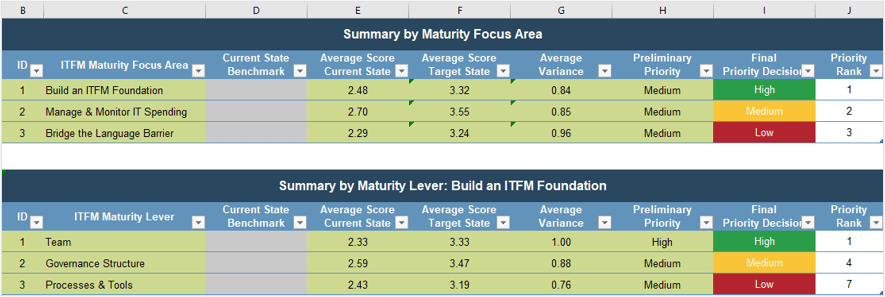
| Column ID | Input Type | Guidelines |
| B | Formula | Automatic calculation, no entry required. |
| C | Formula | Automatic calculation, no entry required: ITFM maturity focus area or lever, depending on the table. |
| D | Placeholder | Ignore this column because it’s a placeholder for future reference. |
| E, F, G | Formula | Automatic calculation, no entry required: average score related to the current state and target state, along with the corresponding variance per maturity focus area or lever (depending on the table). |
| H | Formula | Automatic calculation, no entry required: preliminary priority based on the average variance (column G), where Low corresponds to an average variance between 0 and 0.5 (inclusive), Medium corresponds to an average variance between 0.51 and 0.99 (inclusive), and High corresponds to an average variance greater than or equal to 1. |
| J | Dropdown | Select your final priority (Low, Medium, or High) per ITFM maturity focus area or lever, depending on the table. |
| K | Whole Number | Enter the appropriate rank based on your priorities; do not use the same number more than once. A whole number between 1 and 3 to rank ITFM maturity focus areas, and between 1 and 9 to rank ITFM maturity levers, depending on the table. |
Review the following in the Excel workbook as per guidelines:
- Navigate to tab 3. Assessment Summary.
- Review your current-state and target-state result along with the corresponding variance per maturity focus area and maturity lever.
- Select the appropriate priority for each maturity focus area and maturity lever.
- Enter a unique rank for each maturity focus area (1 to 3).
- Enter a unique rank for each maturity lever (1 to 9).
Download the IT Financial Management Maturity Assessment Tool
Step 3
Communicate your ITFM maturity results
Content Overview
- Review your assessment charts
- Customize the assessment report
- Communicate your results
This step involves the following participants:
- CIO/IT director
- CFO/finance director
- IT finance lead
- IT audit lead
- Other IT management
3. Communicate your ITFM maturity results
3 hours
Input: ITFM maturity assessment results
Output: Customized ITFM maturity assessment report
Materials: 3. Assessment Summary tab in the ITFM Maturity Assessment Tool, ITFM Maturity Assessment Report Template
Participants: CIO/IT director, CFO/finance director, IT finance lead, IT audit lead, Other IT management
- Review assessment charts: navigate to the Assessment Summary tab in the ITFM Maturity Assessment Tool (see next slides) to view your results and related charts.
- Edit the report template: complete the template based on your results and priorities to develop your customized ITFM maturity assessment report (see next slide).
- Communicate results: communicate and deliberate the assessment results with assessment takers at a first stage, and with your stakeholders at a second stage. The objective is to agree on next steps, including developing an improvement plan.
Download the IT Financial Management Maturity Assessment Tool
TEMPLATE & EXAMPLE
Review assessment charts
Excel Workbook: ITFM Maturity Assessment Tool – Assessment Summary worksheet
Refer to the example below on charts depicting different views of the maturity assessment results across the three focus areas and nine levers.
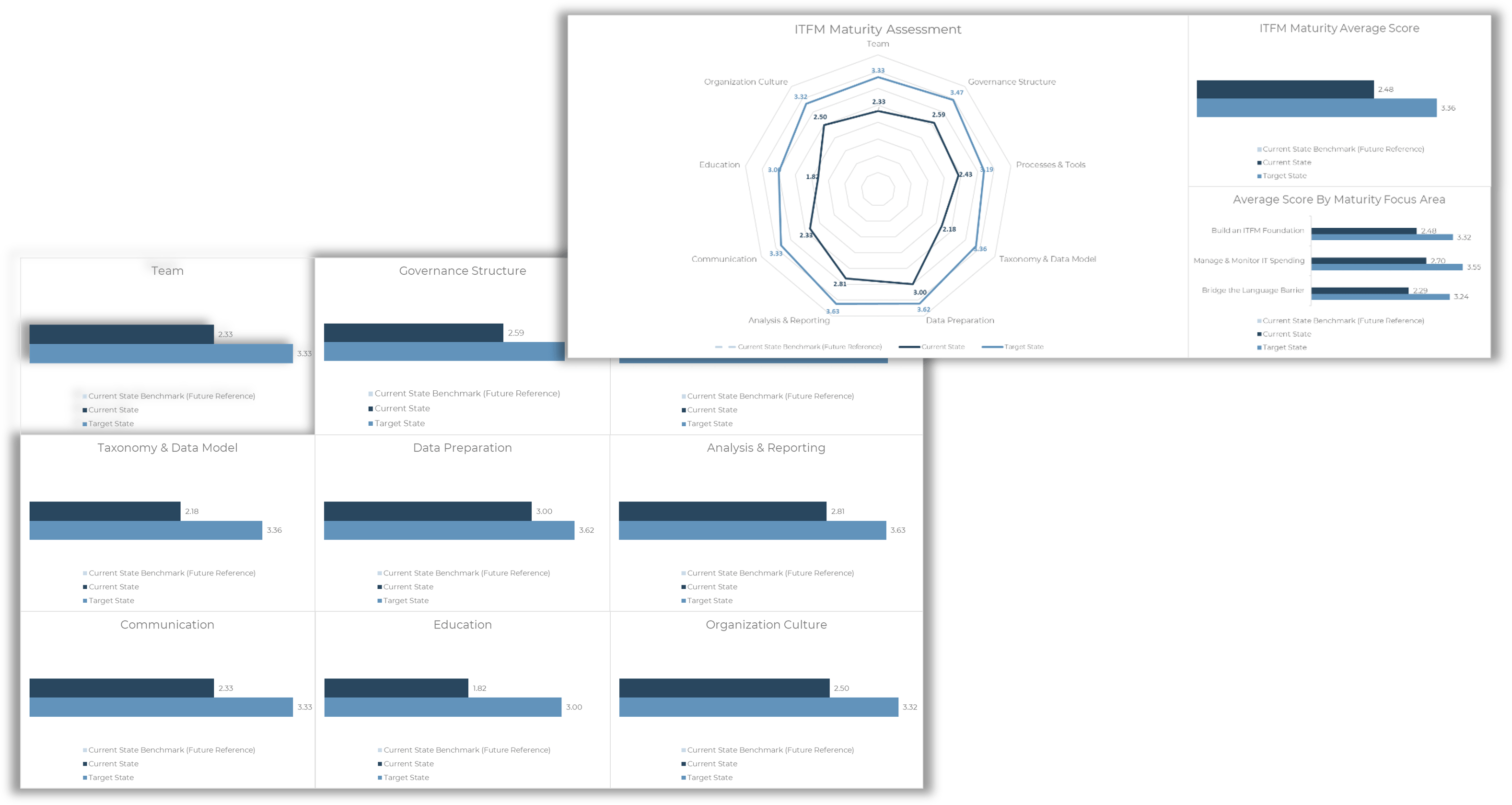
From the Excel workbook, after completing your potential initiatives and filling all related entries in the Outline Initiatives tab:
- Navigate to tab 3. Assessment Summary.
- Review each of the charts.
- Navigate back to the survey tabs to examine, drill down, and amend individual entries as you deem necessary.
Download the IT Financial Management Maturity Assessment Tool
TEMPLATE & EXAMPLE
Customize your report
PowerPoint presentation: ITFM Maturity Assessment Report Template
Refer to the example below on slides depicting different views of the maturity assessment results across the three maturity focus areas and nine maturity levers.
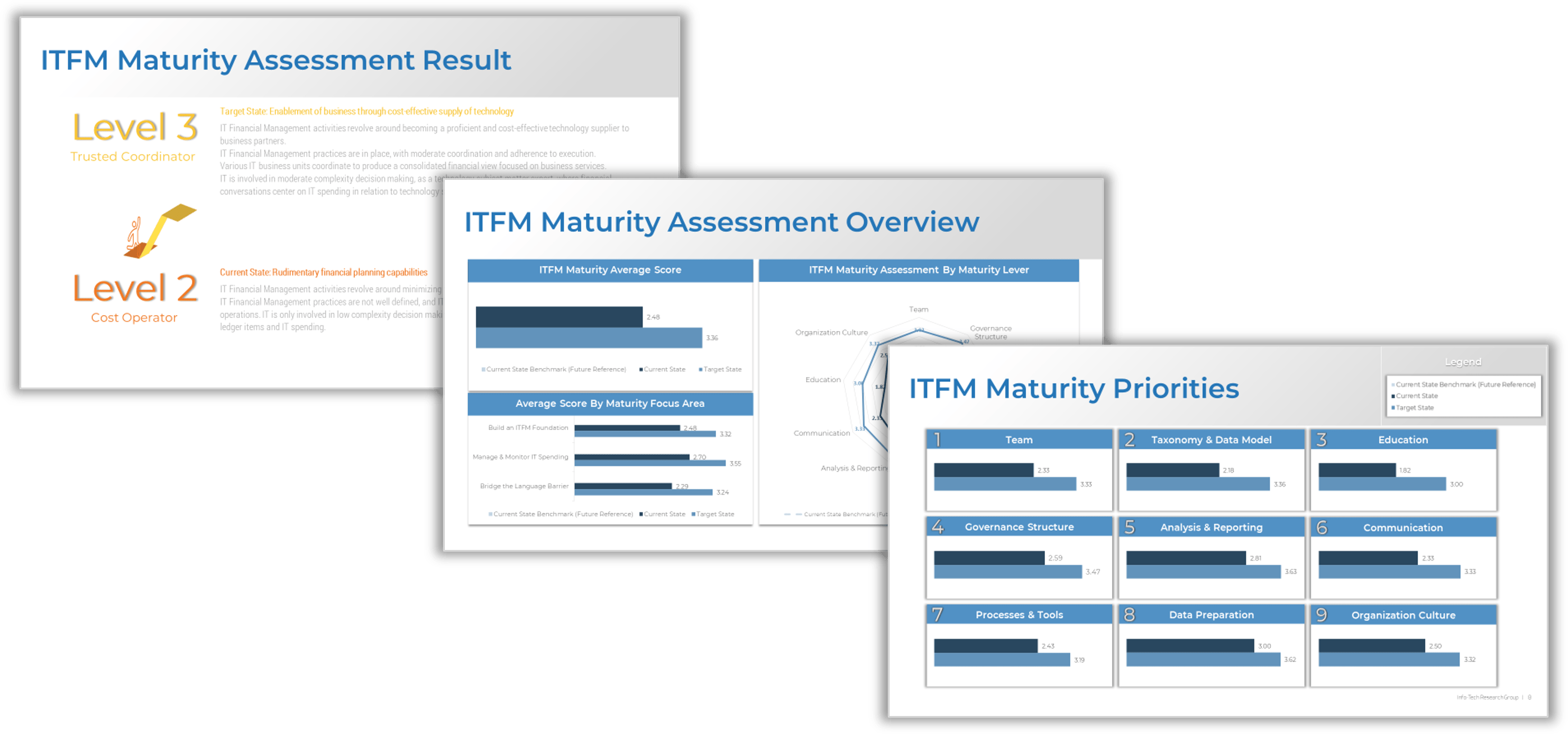
Slide 6: Edit levels based on your assessment results. Copy and paste the appropriate maturity level definition and description from slide 4.
Slide 7: Copy related charts from the assessment summary tab in the Excel workbook and remove the chart title. You can use the “Outer Offset: Bottom” shadow under shape effects on the chart.
Slide 8: Copy related charts from the assessment summary tab in the Excel workbook and remove the chart title and legend. You can use the “Outer Offset: Center” shadow under shape effects on the chart.
From the ITFM Maturity Assessment Report Template:
- Edit the report based on your results found in the assessment summary tab of the Excel workbook (see previous slide).
- Review slides 6 to 8 and bring necessary adjustments.
Download the IT Financial Management Maturity Assessment Report Template
Make informed business decisions
Take a holistic approach to ITFM.
- A thorough understanding of your technology spending in relation to business needs and drivers is essential to make informed decisions. As a trusted partner, you cannot have effective conversations around budgets and cost optimization without a solid foundation.
- It is important to realize that ITFM is not a one-time exercise, but a continuous, sustainable process to educate (teach, mentor, and train), increase transparency, and assign responsibility.
- Move up the ITFM maturity ladder by improving across three maturity focus areas:
- Build an ITFM Foundation
- Manage and Monitor IT Spending
- Bridge the Language Barrier
What’s Next?
Communicate your maturity results with stakeholders and develop an actionable ITFM improvement plan.
And remember, having informed discussions with your business partners and stakeholders, where technology helps propel your organization forward, is priceless!
IT Financial Management Team

|
Dave Kish
Practice Lead, ITFM Practice Info-Tech Research Group |

|
Jennifer Perrier
Principal Research Director, ITFM Practice Info-Tech Research Group |

|
Angie Reynolds
Principal Research Director, ITFM Practice Info-Tech Research Group |

|
Monica Braun
Research Director, ITFM Practice Info-Tech Research Group |

|
Rex Ding
Research Specialist, ITFM Practice Info-Tech Research Group |

|
Aman Kumari
Research Specialist, ITFM Practice Info-Tech Research Group |
Research Contributors and Experts

|
Amy Byalick
Vice President, IT Finance Info-Tech Research Group |
Amy Byalick is an IT Finance practitioner with 15 years of experience supporting CIOs and IT leaders elevating the IT financial storytelling and unlocking insights. Amy is currently working at Johnson Controls as the VP, IT Finance, previously working at PepsiCo, AmerisourceBergen, and Jacobs. |

|
Carol Carr
Technical Counselor, Executive Services Info-Tech Research Group |
|

|
Scott Fairholm
Executive Counselor, Executive Services Info-Tech Research Group |
|

|
Gokul Rajan
Executive Counselor, Executive Services Info-Tech Research Group |
|
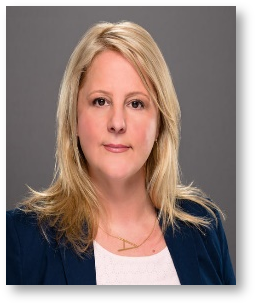
|
Allison Kinnaird
Practice Lead, Infrastructure & Operations Info-Tech Research Group |
|

|
Isabelle Hertanto
Practice Lead, Security & Privacy Info-Tech Research Group |
Related Info-Tech Research
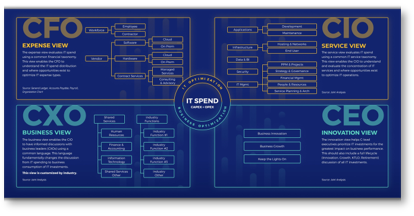
|
Achieve IT Spending Transparency
Mature your ITFM practice by activating the means to make informed business decisions. |
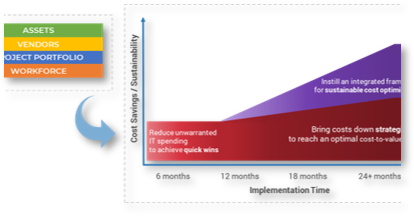
|
Build Your IT Cost Optimization Roadmap
Develop an IT cost optimization strategy based on your specific circumstances and timeline. |
Bibliography
Eby, Kate. “The Complete Guide to Organizational Maturity: Models, Levels, and Assessments.” Smartsheet, 8 June 2022. Web.
“Financial Management Maturity Model.” National Audit Office, n.d. Accessed 28 Apr. 2023.
“ITFM/TBM Program Maturity Guide.” Nicus Software, n.d. Accessed 28 Apr. 2023.
Jouravlev, Roman. "Service Financial Management: ITIL 4 Practice Guide." Axelos, 2020.
McCarthy, Seamus. “Financial Management Maturity Model: A Good Practice Guide.” Office of the Comptroller & Auditor General, 26 June 2018. Web.
“Principles for Effective Risk Data Aggregation and Risk Reporting.“ Bank for International Settlements, Jan. 2013. Web.
“Role & Influence of the Technology Decision-Maker 2022.” Foundry, 2022. Web.
Stackpole, Beth. “State of the CIO, 2022: Focus turns to IT fundamentals.” CIO, 21 March 2022. Web.
“Tech Spend Pulse.” Flexera, 2022. Web.
Appendix A
Definition and Description
Per Maturity Level
ITFM maturity levels and definitions
Maturity Level |
Definition |
Description |
| Nascent Level 1 |
Inability to consistently deliver financial planning services | ITFM practices are almost inexistent. Only the most basic financial tasks and activities are being performed on an ad hoc basis to fulfill the Finance department’s requests. |
| Cost Operator Level 2 |
Rudimentary financial planning capabilities. | ITFM activities revolve around minimizing the IT budget as much as possible. ITFM practices are not well defined, and IT’s financial view is limited to day-to-day technical operations.
IT is only involved in low complexity decision making, where financial conversations center on general ledger items and IT spending. |
| Trusted Coordinator Level 3 |
Enablement of business through cost-effective supply of technology. | ITFM activities revolve around becoming a proficient and cost-effective technology supplier to business partners.
ITFM practices are in place, with moderate coordination and adherence to execution. Various IT business units coordinate to produce a consolidated financial view focused on business services. IT is involved in moderate complexity decision making, as a technology subject matter expert, where financial conversations center on IT spending in relation to technology services or solutions provided to business partners. |
| Value Optimizer Level 4 |
Effective impact on business performance. | ITFM activities revolve around optimizing existing technology investments to improve both IT and business performance.
ITFM practices are well managed, established, documented, repeatable, and integrated as necessary across the organization. IT’s financial view tie technology investments to lines of business, business products, and business capabilities. Business partners are well informed on the technology mix and drive related discussion. IT is trusted to contribute to complex decision making around existing investments to cost-effectively plan initiatives, as well as enhance business performance. |
| Strategic Partner Level 5 |
Influence on the organization’s strategic direction. | ITFM activities revolve around predicting the outcome of new or potential technology investments to continuously optimize business performance.
ITFM practices are fully optimized, reviewed, and improved in a continuous and sustainable manner, and related execution is tracked by gathering qualitative and quantitative feedback. IT’s financial view is holistic and fully integrated with the business, with an outlook on innovation, growth, and strategic transformation. Business and IT leaders know the financial ramifications of every business and technology investment decision. IT is trusted to contribute to strategic decision making around potential and future investments to grow and transform the business. |
Appendix B
Maturity Level Definitions and Descriptions
Per Lever
Establish your ITFM team
Maturity focus area: Build an ITFM foundation.
Maturity Level | Definition | Description |
| Nascent Level 1 | Inability to provide any type of financial insight. | ITFM tasks, activities, and functions are not being met in any way, shape, or form. |
| Cost Operator Level 2 | Ability to provide basic financial insights. | There is no dedicated ITFM team.
|
| Trusted Coordinator Level 3 | Ability to provide basic business insights. | A dedicated team is fulfilling essential ITFM tasks, activities, and functions.
|
| Value Optimizer Level 4 | Ability to provide valuable business driven insights. | A dedicated ITFM team with well-defined roles and responsibilities can provide effective advice to IT leaders, in a timely fashion, and positively influence IT decisions. |
| Strategic Partner Level 5 | Ability to influence both technology and business decisions. | A dedicated and highly specialized ITFM team is trusted and valued by both IT and Business leaders.
|
Set up your governance structure
Maturity focus area: Build an ITFM foundation
Maturity Level | Definition | Description |
| Nascent Level 1 | Inability to ensure any adherence to rules and regulations. | ITFM frameworks, guidelines, policies, and procedures are not developed nor documented. |
| Cost Operator Level 2 | Ability to ensure basic adherence to rules and regulations. | Basic ITFM frameworks, guidelines, policies, and procedures are in place, developed on an ad hoc basis, with no apparent coherence or complete documentation. |
| Trusted Coordinator Level 3 | Ability to ensure compliance to rules and regulations, as well as accountability across ITFM processes. | Essential ITFM frameworks, guidelines, policies, and procedures are in place, coherent, and documented, aiming to (a) comply with rules and regulations, and (b) provide clear accountability. |
| Value Optimizer Level 4 | Ability to ensure compliance to rules and regulations, as well as structure, transparency, and business alignment across ITFM processes. | ITFM frameworks, guidelines, policies, and procedures are well defined, coherent, documented, and regularly reviewed, aiming to (a) comply with rules and regulations, (b) provide clear accountability, and (c) maintain business alignment. |
| Strategic Partner Level 5 | Ability to:
| ITFM frameworks, guidelines, policies, and procedures are complete, well defined, coherent, documented, continuously reviewed, and improved, aiming to (a) comply with rules and regulations, (b) provide clear accountability, (c) maintain business alignment, and (d) facilitate the decision-making process.
|
Adopt ITFM processes and tools
Maturity focus area: Build an ITFM foundation.
Maturity Level | Definition | Description |
| Nascent Level 1 | Inability to deliver IT financial planning and performance output. | ITFM processes and tools are not developed nor documented. |
| Cost Operator Level 2 | Ability to deliver basic IT financial planning output. | Basic ITFM processes and tools are in place, developed on an ad hoc basis, with no apparent coherence or complete documentation. |
| Trusted Coordinator Level 3 | Ability to deliver accurate IT financial output and basic IT performance output in a consistent cadence. | Essential ITFM processes and tools are in place, coherent, and documented, aiming to (a) maintain integrity across activities, tasks, methodologies, data, and reports; (b) deliver IT financial planning and performance output needed by stakeholders; and (c) provide clear accountability. ITFM tools and processes are adopted by the ITFM team and some IT business units but are not fully integrated. |
| Value Optimizer Level 4 | Ability to deliver accurate IT financial planning and performance output at the needed level of detail to stakeholders in a consistent cadence. | ITFM processes and tools are complete, well defined, coherent, documented, continuously reviewed, and improved, aiming to (a) maintain integrity across activities, tasks, methodologies, data, and reports; (b) deliver IT financial planning and performance output needed by stakeholders; (c) provide clear accountability; and (d) facilitate decision-making. ITFM tools and processes are adopted by IT and business partners but are not fully integrated. |
| Strategic Partner Level 5 | Ability to:
| ITFM processes and tools are complete, well defined, coherent, documented, continuously reviewed, and improved, aiming to (a) maintain integrity across activities, tasks, methodologies, data, and reports; (b) deliver IT financial planning and performance output needed by stakeholders; (c) provide clear accountability; and (d) facilitate decision making.
|
Standardize your taxonomy and data model
Maturity focus area: Manage and monitor IT spending.
Maturity Level | Definition | Description |
| Nascent Level 1 | Inability to provide transparency across technology spending. | ITFM taxonomy and data model are not developed nor documented. |
| Cost Operator Level 2 | Ability to provide transparency and support IT financial planning data, analysis, and reporting needs of finance stakeholders. | ITFM taxonomy and data model are in place, developed on an ad hoc basis, with no apparent coherence or complete documentation, to comply with, and meet the needs of finance stakeholders. |
| Trusted Coordinator Level 3 | Ability to provide transparency and support IT financial planning and performance data, analysis, and reporting needs of IT and finance stakeholders. | ITFM taxonomy and data model are in place, coherent, and documented to meet the needs of IT and finance stakeholders. |
| Value Optimizer Level 4 | Ability to provide transparency and support IT financial planning and performance data, analysis, and reporting needs of IT, finance, business, and executive stakeholders. | ITFM taxonomy and data model are complete, well defined, coherent, documented, continuously reviewed, and improved, aiming to provide (a) a holistic view of IT spending and IT performance, (b) visibility and transparency, (c) flexibility, and (d) valuable insights to facilitate data driven decision making.
|
| Strategic Partner Level 5 | Ability to:
| ITFM taxonomy and data model are complete, well defined, coherent, documented, continuously reviewed, and improved, aiming to provide (a) a holistic view of IT spending and IT performance, (b) visibility and transparency, (c) flexibility, and (d) valuable insights to facilitate data driven decision making.
|
Identify, gather, and prepare your data
Maturity focus area: Manage and monitor IT spending.
Maturity Level | Definition | Description |
| Nascent Level 1 | Inability to provide accurate and complete across technology spending. | ITFM data needs and requirements are not understood. |
| Cost Operator Level 2 | Ability to provide accurate, but incomplete IT financial planning data to meet the needs of finance stakeholders. | Technology spending data is extracted, transformed, and loaded on an ad hoc basis to meet the needs of finance stakeholders. |
| Trusted Coordinator Level 3 | Ability to provide accurate and complete IT financial planning data to meet the needs of IT and finance stakeholders, but IT performance data remain incomplete. | IT financial planning data is extracted, transformed, and loaded in a regular cadence to meet the needs of IT and finance stakeholders.
|
| Value Optimizer Level 4 | Ability to provide accurate and complete IT financial planning and performance data to meet the needs of IT, finance, business, and executive stakeholders. | ITFM data needs and requirements are understood.
|
| Strategic Partner Level 5 | Ability to provide accurate and complete IT financial planning and performance data real time and when needed by IT, finance, business, and executive stakeholders. | ITFM data needs and requirements are understood.
|
Analyze your findings and develop your reports
Maturity focus area: Manage and monitor IT spending.
Maturity Level | Definition | Description |
| Nascent Level 1 | Inability to provide any type of financial insight. | ITFM analysis and reports are not developed nor documented. |
| Cost Operator Level 2 | Ability to provide basic financial insights. | IT financial planning analysis is conducted on an ad hoc basis to meet the needs of finance stakeholders. |
| Trusted Coordinator Level 3 | Ability to provide basic financial planning and performance insights to meet the needs of IT and finance stakeholders. | IT financial planning and performance analysis are methodical and rigorous, as defined in related control documents (guideline, policies, procedures, etc.).
|
| Value Optimizer Level 4 | Ability to provide practical insights and useful recommendations as needed by IT, finance, business, and executive stakeholders to facilitate business decision making around technology investments. | ITFM analysis and reports support business decision making around technology investments.
|
| Strategic Partner Level 5 | Ability to provide practical insights and useful recommendations as needed by IT, finance, business, and executive stakeholders to facilitate strategic decision making. | ITFM analysis and reports support strategic decision making.
|
Communicate your IT spending
Maturity focus area: Bridge the language barrier.
Maturity Level | Definition | Description |
| Nascent Level 1 | Inability of organization stakeholders to communicate and understand each other. | The organization stakeholders including IT, finance, business, and executives do not understand one another, and cannot speak the same language. |
| Cost Operator Level 2 | Ability to understand business and finance requirements. | IT understands and meets business and financial planning requirements but does not communicate in a similar language.
|
| Trusted Coordinator Level 3 | Ability to understand the needs of different stakeholders including IT, finance, business, and executives and take part in decision making around technology spending. | The organization stakeholders including IT, finance, business, and executives understand each other’s needs, but do not communicate in a common language.
|
| Value Optimizer Level 4 | Ability to communicate in a common vocabulary across the organization and take part in business decision making around technology investments. | The organization stakeholders including IT, finance, business, and executives communicate in a common vocabulary and understand one another.
|
| Strategic Partner Level 5 | Ability to communicate in a common vocabulary across the organization and take part in strategic decision making. | The organization stakeholders including IT, finance, business, and executives communicate in a common vocabulary and understand one another.
|
Educate the masses
Maturity focus area: Bridge the language barrier.
Maturity Level | Definition | Description |
| Nascent Level 1 | Inability of organization stakeholders to acquire knowledge. | Educational resources are inexistent. |
| Cost Operator Level 2 | Ability to acquire financial knowledge and understand financial concepts. | IT leaders have access to educational resources to gain the financial knowledge necessary to perform their duties. |
| Trusted Coordinator Level 3 | Ability to acquire financial and business knowledge and understand related concepts. | IT leaders and their respective teams have access to educational resources to gain the financial and business knowledge necessary to perform their duties.
|
| Value Optimizer Level 4 | Ability to acquire knowledge, across technology, business, and finance as needed by different organization stakeholders, and the leadership understand concepts across these various domains. | Stakeholders including IT, finance, business, and executives have access to various educational resources to gain knowledge in different domains as needed.
|
| Strategic Partner Level 5 | Ability to acquire knowledge, and understand concepts across technology, business, and finance as needed by different organization stakeholders. | The organization promotes continuous learning through well designed programs including training, mentorship, and academic courses. Thus, stakeholders including IT, finance, business, and executives have access to various educational resources to gain knowledge in different domains as needed.
|
Influence your organization’s culture
Maturity focus area: Bridge the language barrier.
Maturity Level | Definition | Description |
| Nascent Level 1 | Inability to provide and foster an environment of collaboration and continuous improvement. | Stakeholders including IT, finance, business, and executives operate in silos, and collaboration between different teams is inexistent. |
| Cost Operator Level 2 | Ability to provide an environment of cooperation to meet the needs of IT, finance, and business leaders. | IT, finance, and business leaders cooperate to meet financial planning requirements as necessary to perform their duties. |
| Trusted Coordinator Level 3 | Ability to provide and foster an environment of collaboration across the organization. | IT, finance, and business collaborate on various initiatives. ITFM employees are trusted and supported by their stakeholders (IT, finance, and business). |
| Value Optimizer Level 4 | Ability to provide and foster an environment of collaboration and continuous improvement, where employees across the organization feel trusted, supported, empowered, and valued. | Stakeholders including IT, finance, business, and executives support and promote continuous improvement, transparency practices, and collaboration across the organization.
|
| Strategic Partner Level 5 | Ability to provide and foster an environment of collaboration and continuous improvement, where leaders are willing to change, and employees across the organization feel trusted, supported, empowered, and valued. | Stakeholders including IT, finance, business, and executives support and promote continuous improvement, transparency practices, and collaboration across the organization.
|
Buying Options
Assess Your IT Financial Management Maturity Effectively
IT Risk Management · IT Leadership & Strategy implementation · Operational Management · Service Delivery · Organizational Management · Process Improvements · ITIL, CORM, Agile · Cost Control · Business Process Analysis · Technology Development · Project Implementation · International Coordination · In & Outsourcing · Customer Care · Multilingual: Dutch, English, French, German, Japanese · Entrepreneur
Tymans Group is a brand by Gert Taeymans BV
Gert Taeymans bv
Europe: Koning Albertstraat 136, 2070 Burcht, Belgium — VAT No: BE0685.974.694 — phone: +32 (0) 468.142.754
USA: 4023 KENNETT PIKE, SUITE 751, GREENVILLE, DE 19807 — Phone: 1-917-473-8669
Copyright 2017-2022 Gert Taeymans BV